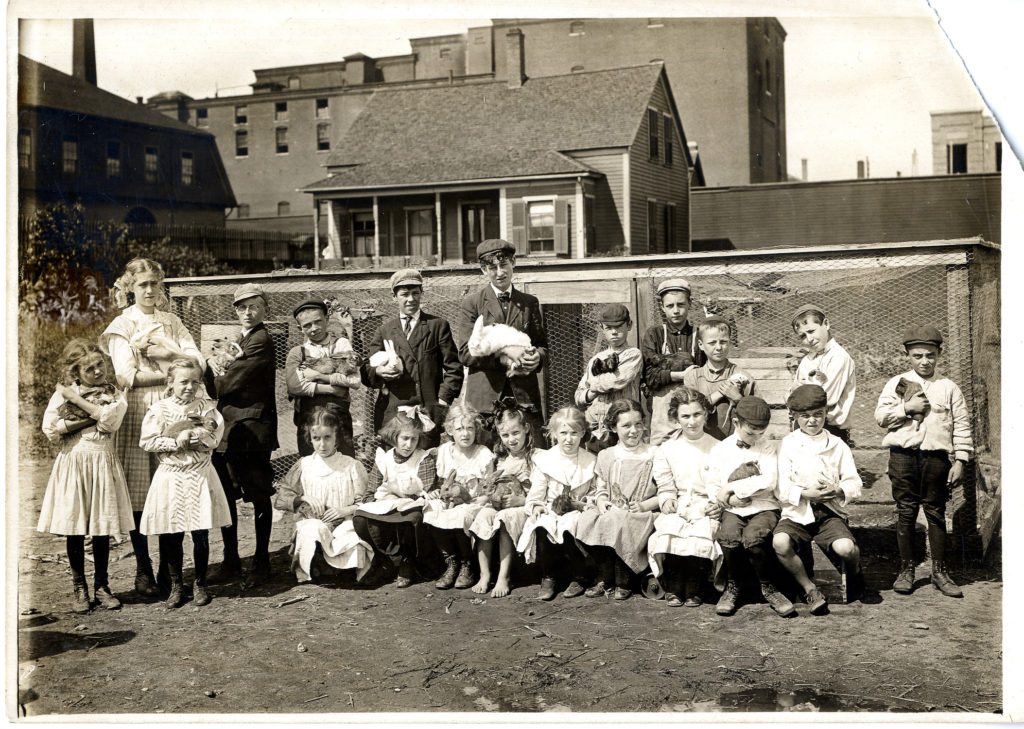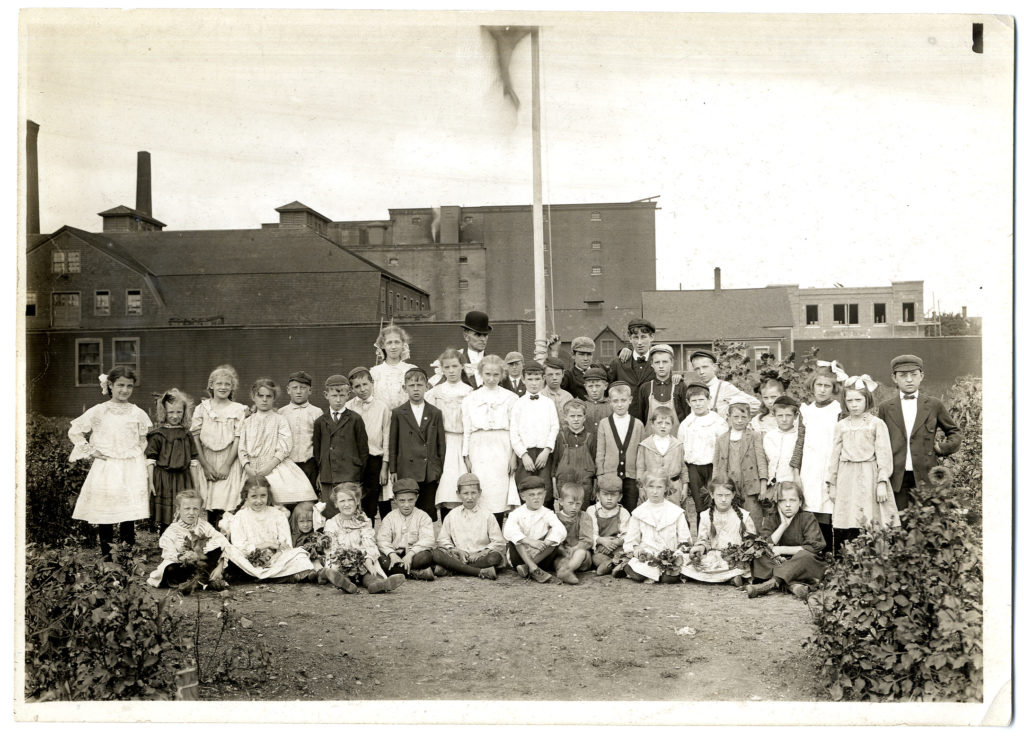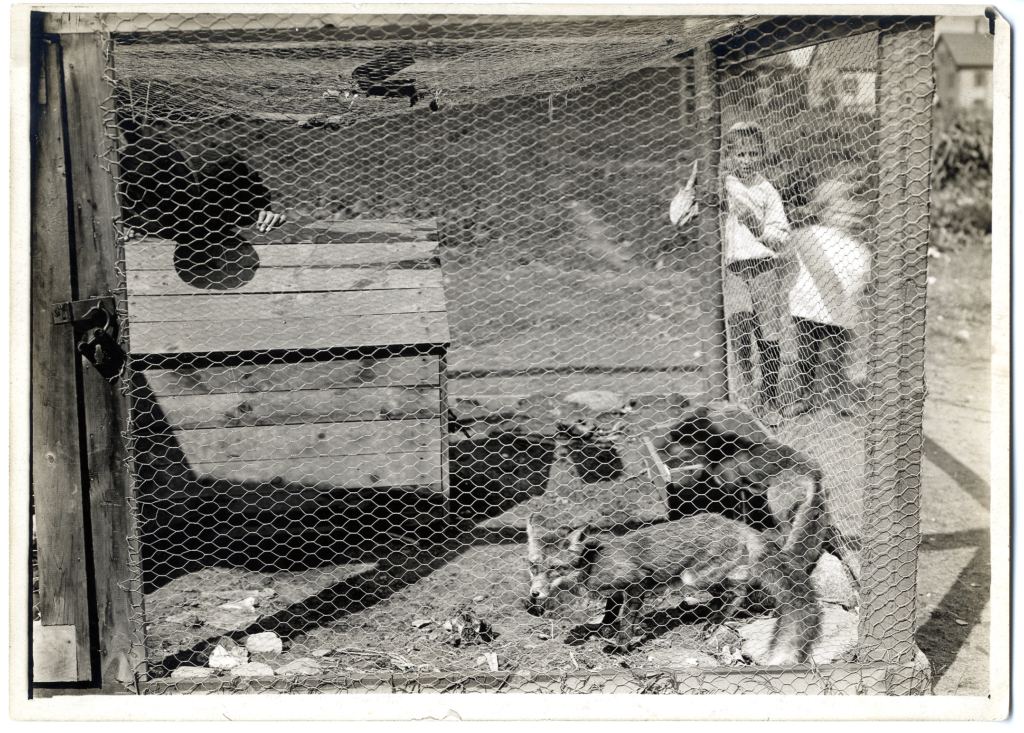My favorite part of cataloging is figuring out a mystery. When little information is given with an object and I am able to solve that mystery, I’m a happy camper. So when a set of three photographs came across my desk, one of them a very sweet image of children holding rabbits and chickens, I wanted to find out the story behind it. Written in pencil on the back of all three photographs was “Garden City group (c1905).” This caption doesn’t help me much. Garden City? Well, New Jersey is the garden state, so maybe there’s a connection there. A little Googling didn’t turn up anything. I then thought, maybe, because many of the other photographs in this miscellaneous box contained views of Worcester, these photos may be from Worcester, too. At least, I wanted it to be of Worcester. Some more Googling and I found it. Garden City was in fact in Worcester.

Garden City was the brain child of Dr. Robert J. Floody, a progressive pastor born in Canada, who preached in Gladwin, Michigan, and Boston, Massachusetts, before coming to Worcester where he is most remembered for his work in social services. Dr. Floody, seeing the petty crimes taking place by some of the adolescent boys in the city’s Island District (South Worcester and Green Island), he sought to help them change their ways. He said he “came to the conclusion that the only way to teach a boy respect for another’s property was to let him have property of his own.”[1] Possibly influenced by the City Beautiful movement of the 1890s and 1900s, Dr. Floody set to work to help revamp at least one parcel in the city. In 1907 he obtained a dump, not so affectionately known as “Dead Cat Dump,” which was owned by Crompton Mills and is today known as Crompton Park. He enlisted the help of the boys and girls of the Island District, ages six to sixteen, many of whom were immigrants of different faiths from Poland, Lithuania, Ireland, Sweden, and France. They completely cleared the more than four-acre lot of old mattresses, bricks, and yes, dead cats. One young girl was reported to have won a prize for carrying out 217 bricks from the dump. The city of Worcester then came and helped prepare the lot for small gardens. Each child was given one of six hundred 10×20-foot plots, five cents, five packets of seeds, and a deed to their garden. Each pathway in the Garden City was named after a prominent Worcester citizen, and two city squares were decorated with flowers and named in honor of Senator George Frisbee Hoar and philanthropist Lucretia Graton.

A city government for Garden City was soon instituted, with the young men being elected to positions as mayor and commissioners of the gardens, streets, tools, and water. (The girls were allowed to vote in the second election, still more than ten years before the rest of the country!) There was also a young police force of forty boys. It was reported that more than five thousand spectators came to Garden City the day the first mayor was inaugurated. Dr. Floody helped the children establish a zoo within the city, and the image here shows some of the citizens holding the animals they kept: rabbits, chickens, a white rat, a hawk, and a raccoon that was supposedly given to the children from Clark University. After the accidental death of the raccoon, the children’s sorrow led them to start a society for the prevention of cruelty to animals. Garden City not only helped the children learn about the value of property and civic engagement, but it also brought the rest of the neighborhood together. Parents of the children were often found tending to their child’s garden or aiding with the animals. The produce grown in the gardens not only helped feed the families of the gardeners, but many were also able to sell the extra for added household income.

After the success of the Garden City in the Island District, at least three more of these cities were started in other areas of Worcester, including one at Beaver Brook and one in a neighborhood referred to as the Meadows (possibly Broad Meadow Brook in the eastern part of the city). Dr. Floody and his wife Adeline oversaw all of the operations of the cities and lectured throughout New England on the success of the project and the importance of their work. Dr. Floody’s cities were known and copied throughout the country; when he died in 1915, his death was reported in newspapers as far away as Honolulu, Hawaii. After Dr. Floody’s death, Adeline Floody took charge of the project until it became too overwhelming, at which point the City of Worcester took over the projects. Although I could not find a date at which the Garden Cities ended, the Island District city has become a large park named Crompton Park, as has Beaver Brook Park, which today also houses one of the city’s many community gardens.
[1] Ethel G. Rockwell, “Worcester’s Garden City,” Our Boys (Milwaukee: October 1910), 12.

This is a fascinating story. I would love to learn more about how the rest of
the country embraced the Floody model. Also – is it possible that the site
of Beaver Brook Park has been a community garden continuously since 1905?
I read that there were garden cities in Noronton and New London, CT, and Pollocksville, NC. I remember an article in the Springfield, Mass paper feeling very strongly that Springfield should start their own city, though I couldn’t find anything on whether that happened or not.
As for the community garden at Beaver Brook, I’m not sure that it existed through the 20th century. The organization that runs Worcester’s community gardens is the Regional Environmental Council of Worcester, who was founded in 1971.
Excellent story and so informative. I wonder if any children of the children who participated in this have any memories that were told to them. I think that the ‘community’ experience would have stuck with these people and helped form their character later in life.
I definitely agree. And if anyone who had a relative involved in the gardens finds this post, I’d love to hear about it and do a follow up!
I would love to learn more! Do you have any other references? Cannot find the one you did mention. (I believe his name was Rev. Robert John Floody)
Thank you for finding that mistake! Here is the link to the article I referenced in the post. https://books.google.com/books?id=oks2AQAAMAAJ&pg=RA1-PA32&dq=%E2%80%9CWorcester%E2%80%99s+Garden+City,%E2%80%9D+Our+Boys&hl=en&sa=X&ved=0ahUKEwiQysuIj6_fAhWRjlkKHYe6BRQQ6AEIKjAA#v=onepage&q=%E2%80%9CWorcester%E2%80%99s%20Garden%20City%2C%E2%80%9D%20Our%20Boys&f=false
Here is another article from another newspaper. I found that when I was researching this, I found the most results when I googled “dead cat dump” and Worcester.
https://news.google.com/newspapers?nid=1915&dat=19121118&id=kPQgAAAAIBAJ&sjid=lnQFAAAAIBAJ&pg=5012,1714862